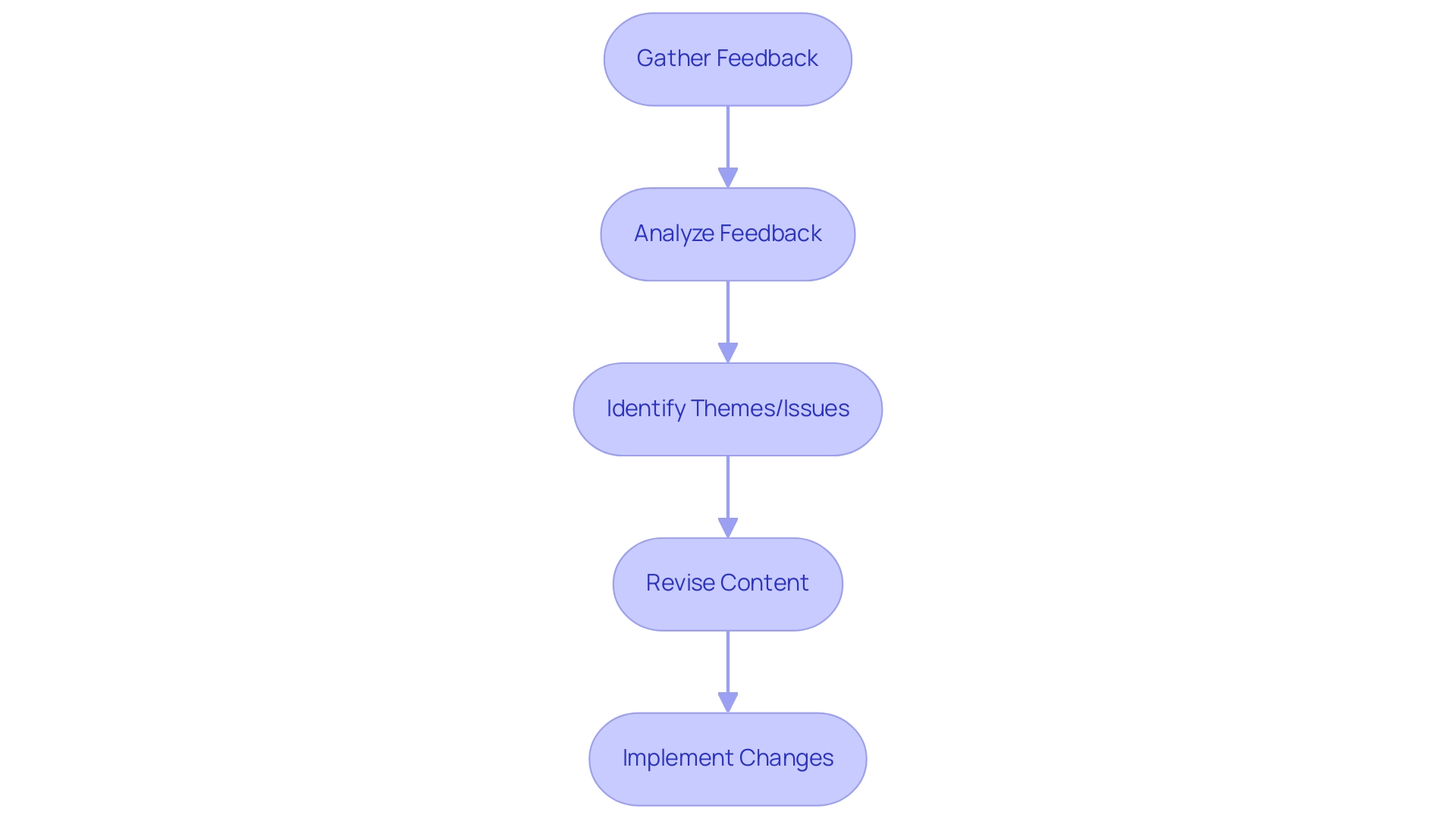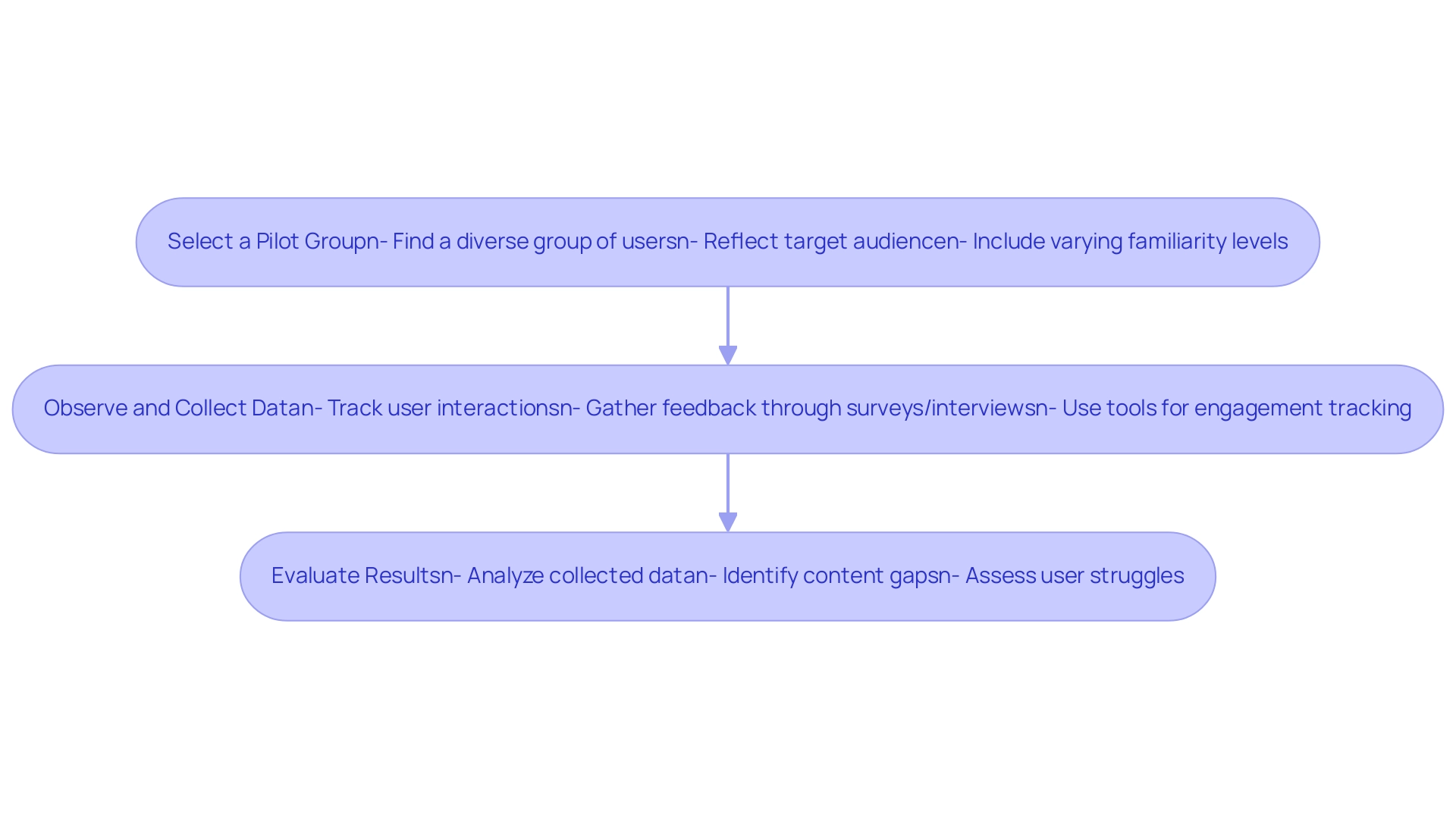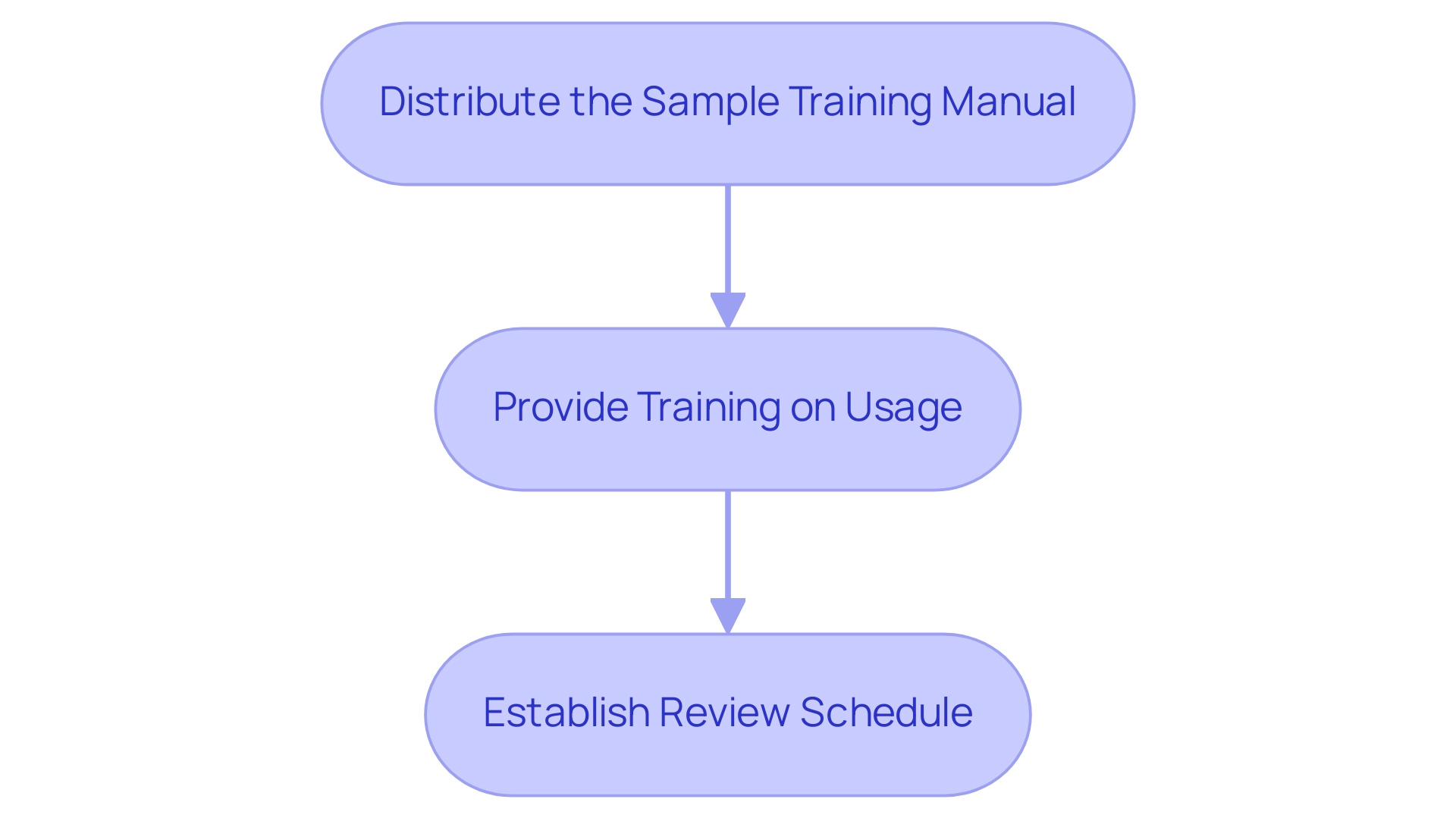
Automation and Documentation
|
July 15, 2025
|
Creating Your Sample Training Manual: A Friendly Step-by-Step Guide
Overview
Creating a sample training manual? You might be wondering why it's so essential. Well, it's all about ensuring consistent onboarding and operational effectiveness in organizations. A well-structured manual—one that lays out clear objectives, organizes content neatly, and gets regular updates—can really boost employee engagement and retention. Did you know that 94% of employees prefer companies that invest in their professional development? That’s a pretty compelling reason to get started!
Key Highlights:
- A training manual is essential for consistent onboarding and operational effectiveness in organizations.
- The demand for training manuals is increasing, with 51% of learning professionals planning upskilling programs.
- SowFlow promotes a systematic approach to documentation, ensuring manuals are regularly updated and relevant.
- 94% of employees prefer companies that invest in their professional development, highlighting the importance of effective training resources.
- Key components of a training manual include objectives, content structure, visual aids, assessment tools, and feedback mechanisms.
- Defining audience needs and objectives is crucial for creating effective training manuals, with 92% of employees believing development goals enhance their experience.
- Gathering and organizing content effectively, including engaging subject matter experts, improves the quality of training materials.
- Choosing the right format, whether digital or print, along with interactive elements, enhances engagement and learning outcomes.
- Incorporating feedback into the training manual development process leads to improved user satisfaction and content effectiveness.
- Pilot testing the manual helps identify gaps and improve user experience before full launch.
- Regularly reviewing and updating the manual ensures it remains relevant and effective over time.
Introduction
In the ever-evolving landscape of modern workplaces, you might be wondering just how crucial training manuals really are. Well, these essential documents are the backbone of employee onboarding, ensuring that new hires have the knowledge and skills they need to thrive in their roles.
As more organizations recognize the value of structured training resources, training manuals are stepping up their game, expanding to include continuous learning and development for all staff members.
Speaking of that, with insights from industry leaders and innovative solutions like SowFlow, let’s dive into the critical components of effective training manuals.
This article offers a comprehensive guide for organizations looking to enhance their training processes and foster a culture of growth and adaptability.
Understanding the Purpose of a Training Manual
You might be wondering why a sample training manual is such a big deal. Well, it’s more than just a bunch of procedures and policies; it’s a vital resource that ensures everyone in your organization gets the same solid training. This consistency is key to maintaining quality and operational effectiveness. By clearly laying out roles and expectations, a good training manual helps new hires get settled in faster and more effectively.
Fast forward to 2025, and the need for these instructional guides has only grown, especially when it comes to onboarding new staff. Did you know that 51% of learning and development pros are planning to roll out upskilling programs? That just shows how crucial organized educational resources are. A sample training manual isn’t just a starting point for newcomers; it’s also a tool for ongoing learning that keeps everyone in the loop, promoting a culture of continuous improvement and sticking to company standards.
Now, let’s talk about SowFlow. They’re shaking things up by treating documentation as a systematic process that fits right into organizations. This approach means manuals aren’t just created and then left to gather dust; they’re regularly updated to reflect the latest procedures and best practices. This method makes instructional materials way more effective and reliable when you need them.
Cesar Zulaica hit the nail on the head when he said, 'This report was guided by insightful interviews with recruiting leaders globally, to whom we owe our sincere gratitude.' It’s a reminder of how important informed perspectives are in understanding development needs. The impact of a sample training manual on onboarding efficiency is huge. Research shows that organizations with a training manual enjoy smoother transitions for new hires, which cuts down on onboarding time and boosts overall productivity.
In fact, 94% of employees prefer companies that invest in their professional development. That really highlights how effective resources play a role in keeping talent and enhancing job satisfaction.
But wait, there’s more! A well-implemented sample training manual can significantly improve operational consistency. Companies that prioritize comprehensive instructional documentation, like SowFlow’s systematic approach, not only streamline onboarding but also build a more knowledgeable workforce, which ultimately boosts their competitiveness in the market. A case study titled "Importance of Workforce Growth Opportunities" shows that employees appreciate growth and development opportunities, with 94% saying they’d stick around longer at companies that invest in their professional growth.
As organizations continue to adapt to rapid changes in the business landscape, the role of a sample training manual in facilitating efficient onboarding and staff development remains crucial.
Key Components of an Effective Training Manual
An efficient sample training manual is a must-have for making sure employees get the thorough instruction they need. With SowFlow's innovative solutions, organizations can empower their teams with instant access to documentation, completely transforming how training materials are created and updated. Thanks to SowFlow's easy creation experience, users can whip up user guides effortlessly, keeping documentation relevant in today’s fast-paced business world.
You might be wondering what makes a well-crafted manual. Typically, it includes a few key components:
- Introduction: This section gives a quick overview of the guide's purpose and scope, setting the stage for what users can expect to learn.
- Objectives: It’s super important to have clearly defined learning goals. These goals outline what staff members should achieve by the end of the program, ensuring that everything aligns with organizational expectations and employee growth.
- Content Structure: An organized layout is crucial for effective learning. Sections should cover various relevant topics in a logical order, making it easy for users to navigate and absorb information. With SowFlow's user guide creation experience, structuring content is a breeze, ensuring clarity and coherence.
- Visual Aids: Who doesn’t love a good diagram or chart? Incorporating visuals can significantly boost understanding. In fact, studies show that educational resources with visual elements can enhance retention rates by up to 65%! In a competitive landscape, where around 1 billion LinkedIn members are actively pursuing jobs and learning opportunities, effective training resources are essential for organizations to stand out.
- Assessment Tools: Including quizzes or evaluations is a great way to measure comprehension and reinforce learning. These tools help identify areas in the training manual that might need a little extra clarification, ensuring that employees really grasp the content. Plus, SowFlow's instant documentation solution makes implementing assessments a piece of cake.
- Feedback Mechanisms: Encouraging users to provide input on the manual's effectiveness fosters continuous improvement. This feedback loop is crucial for adjusting the educational content to meet changing needs and preferences, making sure the documentation stays relevant and efficient.
As Pete Ford points out, "Gen Z is more likely to interact with educational materials, acquiring 50% more learning content than their predecessors." This really highlights the need for instructional guides to be captivating and pertinent. Additionally, insights from case studies on the fastest-growing skills suggest that organizations need to adapt their instructional materials to meet emerging skill demands, enhancing the relevance of the content.
By combining these elements and leveraging SowFlow's features, organizations can create instructional guides that not only communicate information effectively but also engage individuals in their learning journey. Recent discussions about optimizing the ROI of employee development emphasize that a well-organized guide can significantly enhance the overall learning experience, leading to improved performance and productivity. With SowFlow, you can summon the wisdom of your documentation with just a single command, avoiding those unnecessary meetings where you search for answers.
Step 1: Defining Objectives and Audience Needs
Creating an effective sample training manual starts with clearly defining its objectives. This step is super important to make sure the content really meets the needs of its users. So, let’s walk through some key steps together:
- Identify the Audience: Who’s going to use this guide? Understanding your audience is crucial. Think about their roles in the organization, their experience levels, and how they prefer to learn. This insight can help you tailor the content to really engage them and boost effectiveness.
- Set Clear Objectives: What do you want your audience to learn or accomplish with this guide? Using the SMART criteria—Specific, Measurable, Achievable, Relevant, and Time-bound—can help you nail down these objectives. This structured approach not only clarifies expectations but also increases the chances of success. Fun fact: 92% of respondents believe that development goals should enhance a positive employee experience, which shows just how important it is to align objectives with user needs.
- Conduct a Needs Assessment: Have a chat with potential users and stakeholders to find out what knowledge gaps or skills the manual should cover. This step is key, as it ensures the training content is relevant and targeted. For example, a recent study found that 34% of employees skim through compliance information, which points to a disconnect between how content is delivered and its effectiveness. By understanding what your audience needs, you can create materials that truly resonate and facilitate better learning.
Looking ahead to 2025, focusing on establishing learning objectives will be more vital than ever. Organizations are increasingly recognizing the positive impact of development on job engagement. A case study found that 92% of employees believe workplace education boosts their job engagement, emphasizing the need for clearly outlined guides that support employee development. Plus, with about 30% of organizations outsourcing their LMS operations, effective instructional manuals are becoming essential in today’s competitive landscape.
Enter SowFlow—a game changer in this arena! It allows teams to whip up SOPs and educational content in no time. With features like automated screenshot capture and a user-friendly interface, SowFlow makes the documentation process a breeze, letting users focus on what really matters: the content. As Anastasia Masadi, Product Owner, shared, "SowFlow has been a game changer in the way we document work and deliver to our clients. I no longer have to capture each screenshot individually or even leave the browser while creating SOPs and instructional content. SowFlow has given me time back in my life!"
By following these steps and utilizing tools like SowFlow, you can craft a sample training manual that not only informs but also inspires and engages your audience.
As Shannon Jurdana, CEO, pointed out, with 9 in 10 companies planning a return to office by 2025, employers risk losing top talent unless they address flexibility concerns. This highlights the need for flexible educational resources that align with the changing dynamics of the workplace.
Step 2: Gathering and Organizing Content
Once you've clearly defined your objectives, the next crucial step is to gather and organize your content effectively.
You might be wondering where to start. Collect Relevant Information: Begin by gathering all those existing materials—policies, procedures, educational resources—you name it! Engaging subject matter experts (SMEs) is key here; their insights can really boost the accuracy and relevance of your content. Research shows that organizations that tap into the expertise of SMEs during document creation see a significant improvement in the quality and effectiveness of their materials. Plus, with SowFlow's easy creation experience, you can summon the wisdom of your documentation with just a single command, saving you from those endless meetings where you’re just searching for answers. And let’s not forget, with online educational programs accessible from anywhere, it’s super important to ensure that what you gather can adapt to various learning environments.
Now, let’s dive into the next step: Create an Outline. Developing a structured outline helps organize your content into logical sections and subsections. Think of it as the backbone of your guide; it facilitates a smooth flow of information that’s easy for users to navigate. SowFlow makes it a breeze to update and revise your content with user-friendly interfaces and templates, keeping your documentation relevant in our ever-changing business landscape.
Next up, we have Prioritize Content. You need to pinpoint which pieces of information are absolutely essential for achieving your learning objectives. Highlighting these key elements in your sample training manual ensures they stand out, allowing users to focus on what truly matters.
Looking ahead to 2025, current trends spotlight the importance of adaptive educational materials that can be accessed from anywhere, reflecting our shift toward remote and flexible learning environments. As Bassi and McMurrer point out, investing in staff is crucial for enhancing organizational performance—making effective development a must. The case study 'Transforming Learning Leadership' also emphasizes the need for organizations to tweak their development methods in response to advancements in AI, showcasing the evolving landscape of staff education.
By focusing on organizing materials and leveraging SowFlow's features, organizations can craft instructional guides that not only meet immediate educational needs but also adapt to the changing world of staff development. And hey, enhancing benefits strategies that promote work-life balance can really support employees during these transitions!
Step 3: Choosing the Right Format for Your Manual
Choosing the right format for your sample training manual is super important for making teaching effective and engaging. You might be wondering what to consider. Let’s break it down:
- Digital vs. Print: In 2025, organizations face a big choice between digital and print resources. Digital guides are great because they’re easy to update and accessible, which is perfect for the 90% of companies that offer some digital learning. As Tajammul Pangarkar, CMO at Prudour Pvt Ltd, points out, "The structure of educational content can greatly influence how efficiently information is communicated and remembered." But don’t forget about printed guides! They provide a tactile experience that many users appreciate, helping them feel more connected to the material.
- Interactive Elements: Have you thought about adding multimedia features like videos, quizzes, and interactive diagrams? These can really boost user engagement. Research shows that educational materials with interactive elements lead to better retention and learning outcomes. This is especially true for the 68% of employees who prefer to learn while at work and the 58% who want to learn at their own pace.
- User-Friendly Design: A well-structured layout is key for readability and understanding. Think clear headings, bullet points, and enough white space to create an intuitive design. This not only helps with navigation but also ensures users can find the information they need quickly, cutting down on the time they spend searching for answers.
- Real-World Application: Let’s talk about the SowFlow documentation system. It’s a great example of how effective documentation processes can boost productivity and knowledge management. By streamlining documentation, SowFlow helps organizations create instructional guides that not only convey information well but also make the learning environment more engaging.
By carefully considering these elements, organizations can craft a sample training manual that communicates information effectively while also creating a more engaging learning atmosphere. So, what do you think? Ready to dive in and explore these options further?
Step 4: Incorporating Feedback and Making Revisions
Feedback is super important for polishing up your training guide!
You might be wondering how to get started. Well, gathering input is key! Distributing drafts of the guide to stakeholders—like potential users and subject matter experts—can really bring in valuable insights. Involving these folks early on not only fosters collaboration but also ensures that your document tackles real-world needs and challenges.
Now, let’s talk about analyzing feedback. Once you’ve collected it, it’s crucial to review it systematically to spot recurring themes or specific issues. This analysis can uncover gaps in content or areas that need a bit more clarity, ultimately boosting the document's effectiveness.
So, what’s next? Revise accordingly! Based on the insights you’ve gathered, make those necessary adjustments to the content, format, or structure of your document. This iterative process makes sure that the final product is user-friendly and aligns with what your audience really needs. For example, organizations that actively weave feedback into their training manuals have seen significant boosts in staff engagement and comprehension. And here’s a fun fact: studies show that companies using data-driven strategies enjoy 23% greater profitability. Talk about the value of feedback in enhancing instructional effectiveness!
Looking ahead to 2025, the importance of feedback in manual development is clear. With just 69% of employees feeling well-informed about important decisions, organizations really need to focus on transparent communication and actively seek input to build trust and engagement. This statistic highlights the urgency of bridging communication gaps, especially in educational settings.
Plus, with the Asia-Pacific region projected to grow at a rate of 12.2%, adapting educational resources to include user feedback will be vital for keeping a competitive edge in a fast-paced market.
You might be curious about what kinds of adjustments can be made to instructional documents based on user feedback. Think simplifying complex language, adding visual aids, or reorganizing sections for better flow. Case studies, like those on Return to Office strategies, show just how crucial clear communication and tailored benefits are to support employees during transitions. By incorporating input from stakeholders and expert opinions, organizations can ensure their training manuals not only meet current needs but also evolve with changing circumstances. This really reinforces the importance of feedback in crafting effective educational resources.

Step 5: Pilot Testing Your Training Manual
Before you launch your training manual, conducting a pilot test is a must to make sure it’s effective and user-friendly. You might be wondering how to go about it, so let’s break it down:
- Select a Pilot Group: Start by finding a small, diverse group of users that reflects your target audience. It’s important to include folks with different levels of familiarity with the content. This way, you’ll get a well-rounded perspective on how clear and usable your manual really is.
- Observe and Collect Data: During the pilot test, keep an eye on how users interact with the guide. Use tools to track engagement and gather feedback through surveys or interviews. This information is key to understanding user experiences and spotting any hurdles they encounter while navigating the manual. With SowFlow, you can make this process even smoother, as the platform allows for quick updates and revisions, keeping your documentation fresh and effective. Plus, accessing your documentation is a breeze with a single command, making it easier to find what you need.
- Evaluate Results: After the pilot test, take a close look at the data you collected. Identify any gaps in content and areas where users struggled. For instance, a recent study revealed that organizations that conducted pilot testing saw a 30% increase in user satisfaction with their educational resources. This statistic really highlights how crucial pilot testing is for improving documentation quality. By refining these practices, like those seen in the Show Low Documentation System, organizations can boost productivity and knowledge management, leading to smoother operations. And as Satya Nadella put it, "For the first time, we have access to AI that is as empowering as it is powerful," emphasizing how advanced technology can enhance documentation processes. With SowFlow’s user-friendly interface, you can whip up SOPs and instructional resources without leaving your browser, which is a major time-saver.
By following these steps, you can refine your training manual based on real user interactions, resulting in better understanding and retention of the material. This iterative process not only elevates the quality of your documentation but also nurtures a culture of continuous improvement within your organization. As Anastasia Masadi, a Product Owner, remarked, "SowFlow has been a game changer in the way we document work and deliver to our clients. I don’t have to capture each screenshot individually, and I don’t even have to exit the browser while I’m creating SOPs and instructional content. SowFlow gave me time from my life back.

Step 6: Launching and Maintaining Your Training Manual
Once your instructional guide is finalized, what’s next? It’s time for the launch!
First up, you’ll want to distribute the sample training manual. Make sure all staff can easily access it, whether through digital platforms or printed copies—whatever works best. In 2025, efficient distribution is key! Research shows that staff are more likely to engage with educational resources when they’re readily available in different formats. This aligns perfectly with SowFlow's mission to transform documentation, emphasizing the need for flexible educational resources that meet evolving staff needs.
Next, let’s talk about providing training on usage. You’ll want to hold sessions that teach staff how to use the guide effectively. Highlighting the importance of the sample training manual as a go-to resource for ongoing education and reference can really enhance the learning experience. Plus, did you know that Gen Z workers engage with educational resources much more than previous generations? They consume about 50% more learning content! This makes effective instruction on usage even more vital. And don’t forget about cost-effective communication methods, like email marketing, to keep everyone in the loop and maintain those important relationships. It’s all part of SowFlow's user-friendly approach to knowledge management.
Now, let’s move on to establishing a review schedule. Implement a regular review process to keep the guide updated with any changes in policies, procedures, or educational needs. This way, your guide stays relevant and effective over time. In 2025, having up-to-date educational materials is crucial for nurturing a culture of continuous improvement and adaptability within organizations. The shift towards content development in marketing budgets really highlights the importance of investing in quality material—something that’s just as relevant for instructional guides and aligns with SowFlow's vision of seamless workflow capture.
By following these steps, operations managers can ensure that their sample training manual is not just launched effectively but also serves as a dynamic resource that grows with the organization’s needs. If you’re looking for more help in creating effective training manuals, why not reach out to SowFlow today? We’re here to support your documentation needs!

Conclusion
You know, training manuals really are a game-changer in today’s workplace. They’re not just boring documents; they’re essential tools that help onboard new employees and keep everyone growing. By laying out procedures, policies, and best practices clearly, these manuals ensure that everyone gets the training they need, which in turn boosts operational efficiency and quality. As companies start to see the value in structured training resources, it’s super important to keep those manuals updated to reflect what’s really going on.
Now, let’s talk about what makes a training manual truly effective. Think about it:
- Clear objectives
- Organized content
- Visual aids
- Feedback mechanisms
can really take things to the next level. With innovative tools like SowFlow, organizations can make the documentation process a breeze, allowing for quick updates and better engagement with training materials. This kind of flexibility not only nurtures a culture of continuous improvement but also caters to the changing needs of employees, especially as remote and flexible learning becomes more common.
In the end, having well-implemented training manuals can lead to happier employees, better retention, and increased productivity. By focusing on effective training resources, companies can build a knowledgeable workforce that excels in a competitive environment. As the business world keeps evolving, investing in comprehensive training manuals will be key to fostering growth, adaptability, and long-term success. So, are you ready to dive into the world of effective documentation?
Frequently Asked Questions
Why is a sample training manual important for organizations?
A sample training manual ensures consistent training for all employees, helping them settle in faster and maintain quality and operational effectiveness.
How has the need for training manuals changed by 2025?
The need for training manuals has grown significantly, especially for onboarding new staff, with many learning and development professionals planning to implement upskilling programs.
What role does SowFlow play in the creation of training manuals?
SowFlow treats documentation as a systematic process, ensuring that manuals are regularly updated to reflect the latest procedures and best practices, enhancing their effectiveness and reliability.
What impact does a sample training manual have on onboarding efficiency?
Organizations with a training manual experience smoother transitions for new hires, reducing onboarding time and boosting overall productivity.
How do employees perceive companies that invest in their professional development?
94% of employees prefer companies that invest in their professional development, indicating that effective resources can enhance job satisfaction and retention.
What are the key components of a well-crafted training manual?
Key components include an introduction, clearly defined objectives, organized content structure, visual aids, assessment tools, and feedback mechanisms.
Why are visual aids important in training manuals?
Visual aids can significantly enhance understanding and retention rates, with studies showing that educational resources with visuals can improve retention by up to 65%.
How can assessment tools be utilized in training manuals?
Assessment tools, such as quizzes, help measure comprehension and reinforce learning, ensuring employees grasp the content effectively.
What is the significance of feedback mechanisms in training manuals?
Feedback mechanisms encourage users to provide input on the manual’s effectiveness, fostering continuous improvement and ensuring the documentation remains relevant.
How does Gen Z's approach to learning impact training manual design?
Gen Z engages more with educational materials, necessitating that instructional guides be captivating and relevant to meet their learning preferences and emerging skill demands.
👍
What others are liking
5 Steps to outline your ideal documentation structure
5 MINS READ
Where to start the your journey of mapping out your ideal documentation structure, aligning it with the very heartbeat of your organization?
Defining a winning level of detail in your process
3 MINS READ
What is too much detail, and what is too little? This article described in that winning level detail about what detail is enough.





